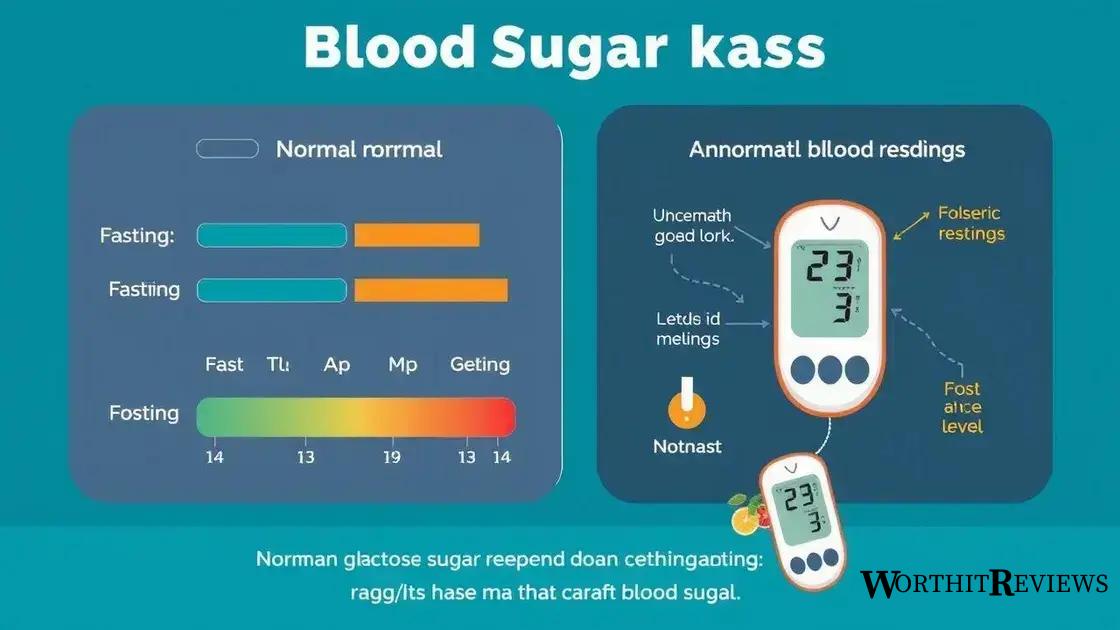Diabetic blood sugar readings indicate how well your body processes glucose, with normal levels ranging from 70 to 99 mg/dL when fasting and below 140 mg/dL after meals.
Are you familiar with how diabetic blood sugar readings can impact your health? Many people overlook their significance. Let’s dive into what these readings really mean and how they can guide your wellness journey.
What do diabetic blood sugar readings indicate?
When it comes to managing diabetes, understanding diabetic blood sugar readings is crucial. These readings can tell you a lot about how well your body is processing glucose.
Normal Blood Sugar Levels
In general, normal blood sugar levels for people without diabetes are between 70 and 99 mg/dL when fasting. After eating, levels can rise but should ideally remain below 140 mg/dL.
Pre-Diabetic and Diabetic Levels
If your fasting blood sugar levels are between 100 and 125 mg/dL, you may be considered pre-diabetic. A reading of 126 mg/dL or higher indicates diabetes. These levels highlight the need for monitoring and management.
Impact of Time of Day
Blood sugar levels can fluctuate throughout the day, influenced by factors like meals, physical activity, and stress. Morning readings can often be elevated due to the dawn phenomenon, where hormones increase glucose production as you wake up.
Understanding Variability
It’s important to track your readings over time to get a complete picture. Consistent high readings can signify that your diabetes management plan needs adjustment, while frequent lows could indicate overmedication.
Consulting Healthcare Providers
Understanding your readings alone can be overwhelming. It’s essential to share them with your doctor or diabetes educator to tailor your treatment plan effectively. They can provide insights and adjustments based on trends in your glucose levels.
Understanding normal and abnormal readings

To effectively manage diabetes, it’s essential to know the difference between normal and abnormal blood sugar readings.
Normal Blood Sugar Levels
For most adults, normal blood sugar levels should range between 70 and 99 mg/dL when fasting. After meals, levels can be higher, typically under 140 mg/dL. Keeping your blood sugar within this range is important for maintaining overall health.
Pre-Diabetes Indicators
If your fasting blood sugar readings fall between 100 and 125 mg/dL, you may be classified as pre-diabetic. This means your body is starting to have trouble regulating sugar, which can lead to more serious health issues if not monitored and managed.
Diabetes Diagnosis
A fasting blood sugar level of 126 mg/dL or higher indicates diabetes. Regular monitoring of your blood sugar is vital to determine whether your management plan is effective or if you need to consult a healthcare provider.
Impact of Variability
Blood sugar levels can vary based on several factors, including diet, exercise, and stress. Understanding how different foods affect your readings can help you make better choices to keep your levels stable.
When to Seek Help
If you notice consistently high or low readings, it’s important to reach out to your healthcare provider. They can help adjust your treatment plan and provide guidance on lifestyle changes to improve your readings.
How to monitor your blood sugar effectively
Monitoring your blood sugar effectively is vital for managing diabetes well. Here are some key strategies to help you keep track:
Regular Testing
Check your blood sugar levels regularly, especially if you are on medication. Aim to test at the same times each day to establish a routine. This could be before meals, after meals, or as recommended by your healthcare provider.
Use a Reliable Glucose Meter
Invest in a high-quality glucose meter that is easy to use and provides quick results. Follow the manufacturer’s instructions for accurate readings, and make sure to keep your meter clean.
Record Your Readings
Keep a journal or use a mobile app to record your blood sugar readings. Include the date, time, and any food or activities that may have affected your levels. This will help you and your doctor identify patterns over time.
Monitor for Symptoms
Pay attention to how you feel in relation to your blood sugar levels. Symptoms of high blood sugar include excessive thirst and fatigue, while low blood sugar can cause dizziness and sweating. Recognizing these symptoms can help you take action before problems escalate.
Consult with Your Healthcare Team
Regularly discuss your readings with your doctor or diabetes educator. They can help you adjust your diet, exercise, or medication based on your monitoring results. Collaborating with your healthcare team ensures you have the best management plan in place.
Diet and its influence on blood sugar levels

Your diet plays a crucial role in managing blood sugar levels. The foods you eat can have a direct impact on your glucose control. Here are important points to consider:
Carbohydrates and Blood Sugar
Carbohydrates are the main nutrient that affects blood sugar levels. Foods high in carbohydrates can cause spikes in blood sugar. It’s essential to choose complex carbohydrates, such as whole grains, fruits, and vegetables, which are digested more slowly compared to simple sugars.
Importance of Fiber
Incorporating fiber-rich foods into your diet can help regulate blood sugar levels. Fiber slows down digestion and the absorption of sugar, leading to more stable blood sugar. Foods like beans, lentils, and whole grains are excellent sources.
Protein and Fats
Adding healthy protein and fats to your meals can also help maintain balanced blood sugar. Foods such as lean meats, fish, nuts, and seeds can slow the absorption of carbohydrates, preventing sudden spikes in glucose levels.
Meal Timing
Consider when you eat as much as what you eat. Eating smaller, frequent meals throughout the day can help keep your blood sugar levels stable. Avoid skipping meals, which can lead to larger fluctuations in blood sugar.
Consulting a Nutritionist
Working with a registered dietitian or nutritionist can provide you with a personalized meal plan tailored to your needs. They can help you understand how different foods affect your blood sugar and support you in making healthier choices.
Tips for improving your diabetic management
Improving your diabetic management involves a combination of lifestyle changes and regular monitoring. Here are some effective tips:
Set Realistic Goals
Establish achievable goals for your blood sugar levels. Discuss these with your healthcare provider to ensure they are safe and effective. Small, incremental changes can lead to significant improvements over time.
Stay Active
Regular physical activity is beneficial for managing diabetes. Aim for at least 150 minutes of moderate exercise each week. Activities such as walking, swimming, or cycling can help lower blood sugar levels and improve overall health.
Follow a Balanced Diet
Focus on a balanced diet rich in fruits, vegetables, whole grains, and lean proteins. Avoid sugary snacks and processed foods that can cause spikes in blood sugar. Meal planning can help you make healthier choices.
Monitor Your Levels
Keep track of your blood sugar readings regularly. Use a glucose meter to identify patterns and learn how food, exercise, and medication affect your levels. This information is valuable for making informed adjustments to your management plan.
Educate Yourself
Understanding diabetes and how it affects your body is crucial. Attend diabetes education classes or workshops. This knowledge can empower you to make better decisions regarding your health.
Stay Hydrated
Drinking enough water is important for everyone, but it is especially vital for people with diabetes. Proper hydration can help keep your blood sugar levels stable and prevent dehydration, which can affect your overall health.
Consult Your Healthcare Team
Regular check-ups with your healthcare team will help you stay on track. They can offer guidance, adjust your treatment plan as needed, and help you stay motivated in your diabetes management journey.
In conclusion, managing diabetes effectively is key to living a healthier life
Understanding your blood sugar readings and how your diet and lifestyle choices affect them is vital. By incorporating regular monitoring, engaging in physical activity, and following a balanced diet, you can take control of your health.
Staying informed through education and collaborating with your healthcare team can significantly improve your diabetes management. Lastly, remember that making small changes can lead to big improvements over time.
Take the steps today to lead a healthier and more fulfilling life with diabetes.
FAQ – Frequently Asked Questions about Diabetes Management
What should my target blood sugar levels be?
For most adults, the target fasting blood sugar level should be between 70 and 99 mg/dL, while levels after meals should ideally be under 140 mg/dL.
How often should I test my blood sugar?
It is recommended to test your blood sugar regularly, especially if you are on medication. Many people test before meals and at bedtime.
What foods should I avoid to manage my blood sugar?
Avoid sugary snacks, processed foods, and foods high in simple carbohydrates, as they can cause spikes in blood sugar levels.
How can exercise affect my blood sugar levels?
Regular exercise can help lower blood sugar levels and improve insulin sensitivity, making it an important part of diabetes management.
Should I consult a dietitian for diabetes management?
Yes, working with a registered dietitian can help you create a personalized meal plan that meets your needs and supports better blood sugar control.
What are some signs I need to watch for regarding low blood sugar?
Common signs of low blood sugar include dizziness, sweating, shaking, and confusion. It’s important to treat low blood sugar promptly.
